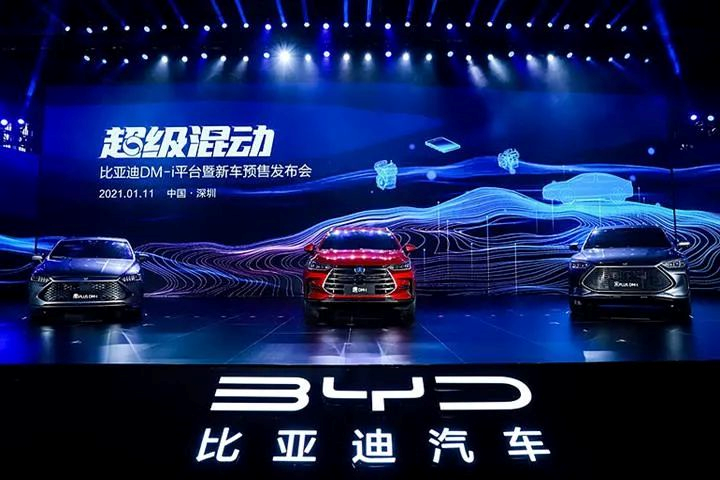Contributor: Painless and Happy
Editor: Wang Lingfang
On October 3rd, BYD announced its production and sales report for September. The production of new energy passenger vehicles reached 204,600 units, and sales of such vehicles reached 201,000 units, both surpassing the 200,000 mark. BYD became the first independent brand to achieve monthly sales of over 200,000 units.
From January to September, BYD produced 1,191,600 new energy vehicles, a YoY increase of 248.74%, and sold approximately 1,180,000 new energy vehicles, a YoY increase of 249.56%, with new energy passenger vehicles accounting for 1,175,300 units, a YoY increase of 255.3%.
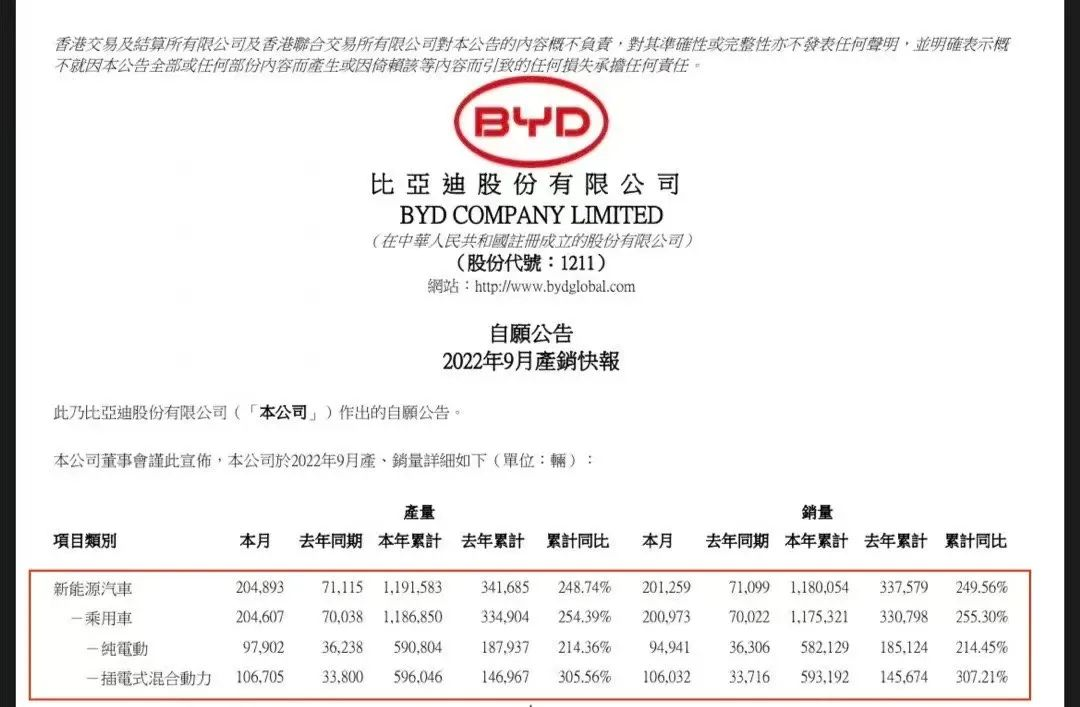
Also, BYD’s sales of 201,000 units in September not only surpassed Tesla’s global sales of approximately 190,000 units, but also helped BYD’s cumulative sales from January to September to reach 1,191,500 units, surpassing Tesla’s 908,600 units, and regaining the global new energy vehicle sales crown for monthly, quarterly and yearly accumulations.
Recently, rumors about BYD’s sales target of 4 million units for 2023 have been widely circulating in the market.
Different groups have different views on the 4 million units target.
Most automakers do not agree:
“Haven’t independent brands been leading the way for only three to five years in the past 20 years?”
“BYD is only riding on the wave of new energy vehicles. Who knows what changes will happen in the future?”
“4 million units? That’s too exaggerated, exceeding the peak period of North and South Volkswagen! How could it be possible?”
…
Fans of new forces say:
“If BYD really reaches 4 million units, that would be terrifying! Tesla’s growth rate is also passive now, and slow growth is losing ground!”
Many well-known investors also say:
“The sales ceiling for a single domestic brand is 1.2 million units, so those who shout 2 million, 3 million, or even 4 million, are just saying for the sake of saying.”
What does selling 3.5-4 million units a year for a single brand really mean? What are the chances of BYD achieving sales of 4 million units per year?
Today, we will discuss this from three dimensions.
From the historical sales perspective, what does 4 million annual sales mean?
First, let’s take a look at the sales data for passenger vehicles in the Chinese market from 2012 to August 2022: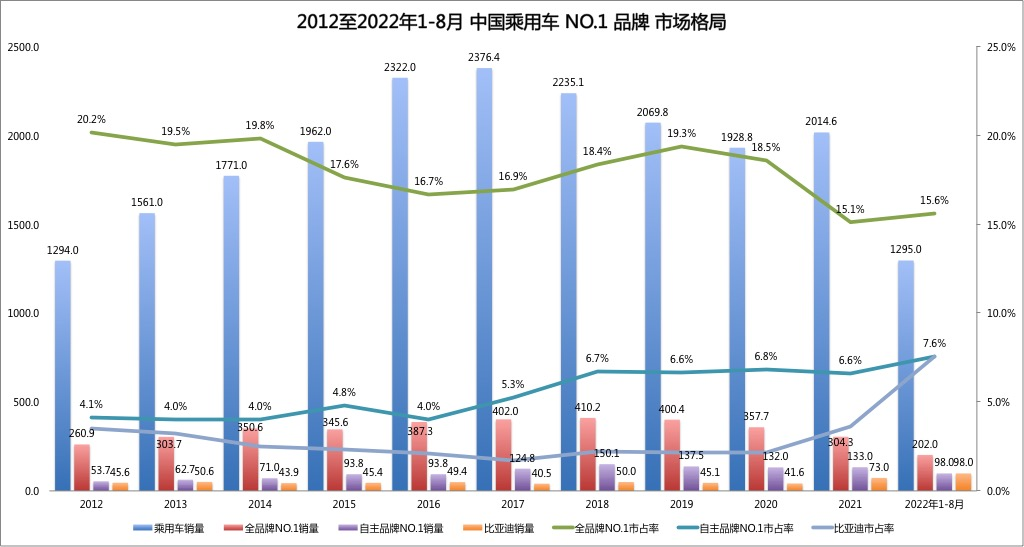
Starting from 2012, China’s passenger car market began to accelerate its upward growth trend, reaching a peak period of 23.764 million vehicles in 2018, and then showed a trend of rise and fall, with sales returning to a level of around 20 million vehicles.
This sales level has been stable for three years within plus or minus 5% of 20 million vehicles, and it is expected to be the fourth year this year. In the short term, the sales of the passenger car market are estimated to be around 20 million vehicles (fluctuating up and down by about 5%) to estimate the total capacity of the overall market.
1. China’s overall market NO.1 brand – Volkswagen
Volkswagen Group has been relatively reliant on the Chinese market since 2005. From 2016 to 2020, with the peak of China’s passenger car sales, Volkswagen reached its sales peak of 3.6-4.1 million vehicles.
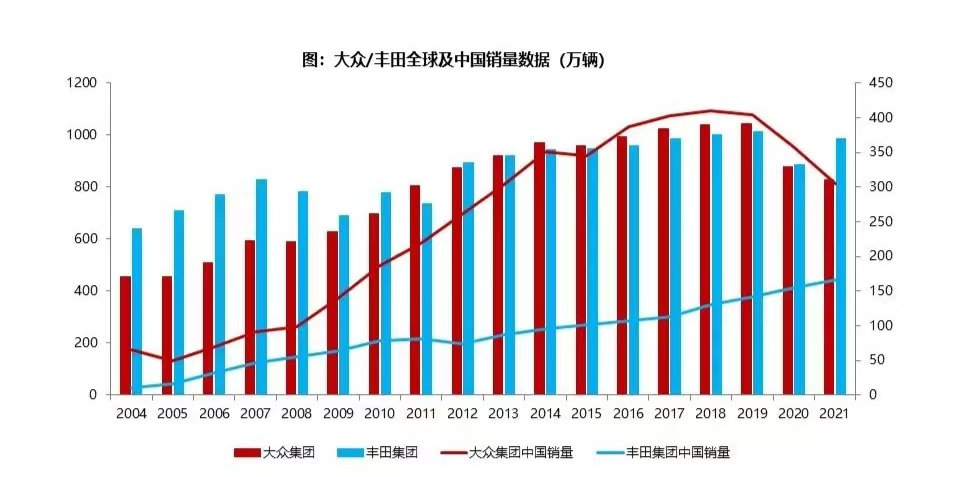
However, Volkswagen’s market share level in China has shown a downward trend as the market expands rapidly, from 20% in 2012 to 16.7% in 2016, and the market share rebounded to 19.3% in 2019. Since 2021, Volkswagen’s market share has rapidly declined due to the impact of new energy and supply chain (chips), from 18.5% in 2020 to 15.1% in 2021.
Even from this year, the Volkswagen brand may gradually become “Minority” rather than “Volkswagen”.
Taking the A-class sedan, which is the most important model of the Volkswagen brand, as an example, the sales volume of the top three A-class sedans, Lavida, Bora, and Sagitar, in the first eight months of 2022 were 220,300 units, 140,100 units, and 139,900 units respectively, a year-on-year decrease of 22.54%, 23.39%, and 12.39%, respectively.
Passat and Magotan, the top five B-class sedans, also showed a year-on-year decline in insured volume from January to August this year.
By 2023, we will find that more and more ordinary consumers no longer like Volkswagen.
2. No.1 domestic brand in the new energy era – BYD
After entering the new energy era, the pattern of the entire vehicle market has undergone significant changes.
1) The share of domestic brands has increased significantly – from 38% to 50%, and then to 70%.
In 2014, the market share of domestic auto brands dropped to a 10-year low of 38.4%. With the rapid development of new energy, the market share of domestic auto brands has grown at a rate of more than 10% per year since 2020, reaching a high of 47.8% in the first 8 months of this year, the highest level in nearly 10 years.
Assuming there are no surprises, the market share of domestic auto brands is expected to exceed 50% this year, and is expected to rise to 70% by 2025 or 2026.
2) The sales structure of domestic auto brands has been fully upgraded, entering the range of above 200,000 yuan from 100,000 to 150,000 yuan.

In 2021, the proportion of domestic auto brands with sales below 100,000 yuan was 48.83%, and the overall average price level was about 120,000 to 130,000 yuan (based on customer purchase caliber, which is about 100,000 to 110,000 yuan based on revenue caliber). With the wave of increased purchase and exchange, as well as domestic auto brands’ overall replacement of joint venture brands, the proportion of domestic passenger cars priced above 200,000 yuan is expected to continue to increase. It is expected that the overall average price in 2025 will exceed 150,000 yuan, entering the range of 150,000 to 200,000 yuan.
3) Domestic auto brands lead in new energy vehicle sales, from 12.2% to 43.3%, and then to 70%.
During this wave of new energy cycles, domestic auto brands’ “quick response capability + new energy technology reserves” has become the biggest advantageous factor in surpassing traditional joint venture brands.
In 2020, the new energy penetration rate of domestic auto brands was 12.2%, while that of luxury car brands was 7.0%, and the new energy penetration rate of joint venture brands was only 1.0%. By the first 8 months of 2022, the new energy penetration rate of domestic auto brands has reached 43.3%, while that of luxury car brands is 24.5%, and the new energy penetration rate of joint venture brands has not changed significantly, at a mere 4.0%.
It can be said that whether in terms of market sensitivity, quick response capability, or new energy technology reserves, traditional joint venture car companies are not just a little behind in the new energy era, they are significantly lagging behind.
4) BYD is the biggest beneficiary in the new energy era, no one else comes close.
BYD has significant influence in terms of technology reserves, industrial chain depth, and a firm grasp of mainstream markets, and even the formulation of new energy policies.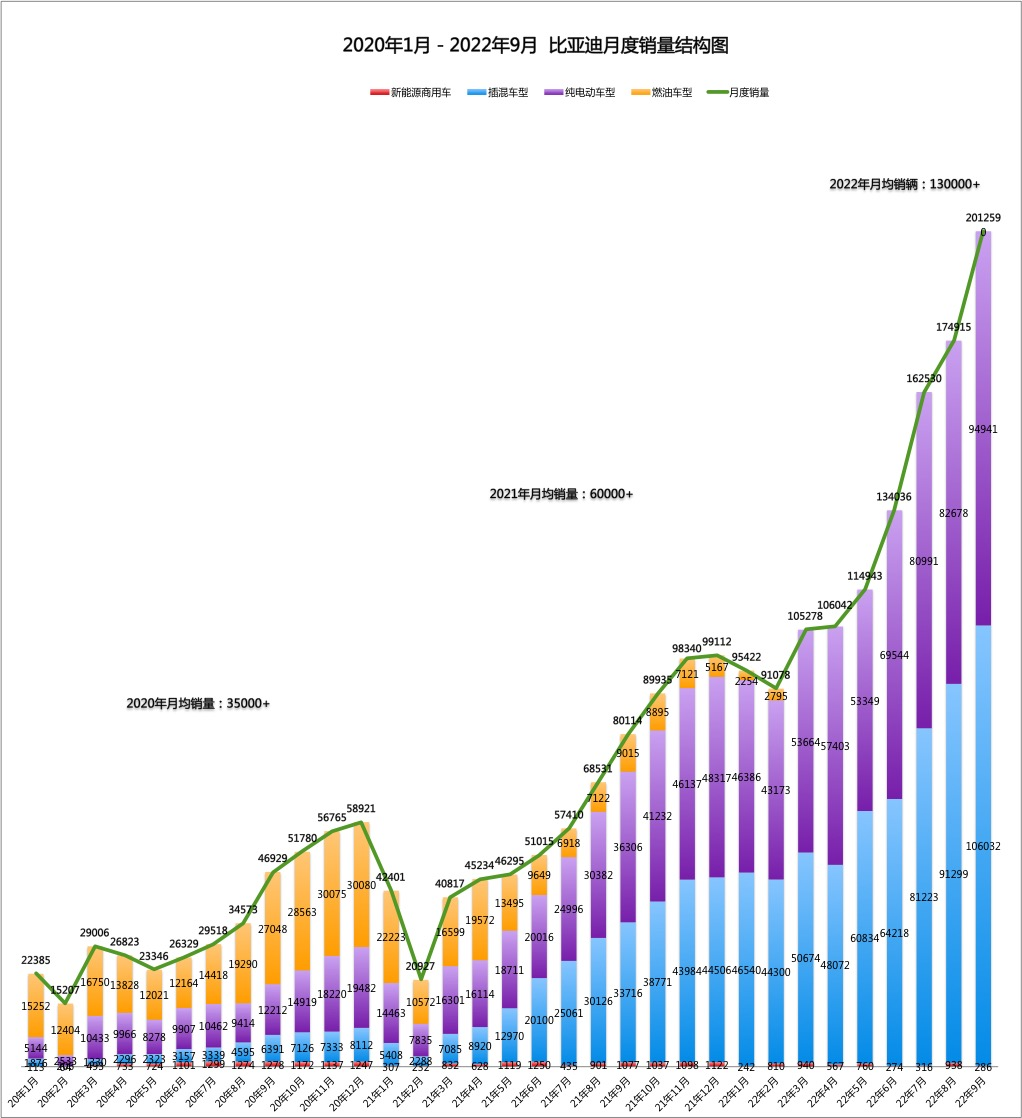
Therefore, BYD’s market share has increased from 2.2% in 2020 to 7.6% from January to August 2022, a three-year growth of 3.45 times, surpassing Geely to become the NO.1 in the sales of new domestic brands in 2022.
Estimating BYD’s Sales in 2022 from its Hit Products
1. BYD’s Product Matrix in 2022
Based on the sales chart of 12 main sub-segments of passenger vehicles in the first half of the year, the three main product types of sedans, SUVs, and MPVs are differentiated into 12 main sub-segments according to different levels of A00\A0\A\B\C, excluding sub-segments that don’t belong to the 5 major sub-segments of A0-level sedans, A/B-level sedans, and SUVs.
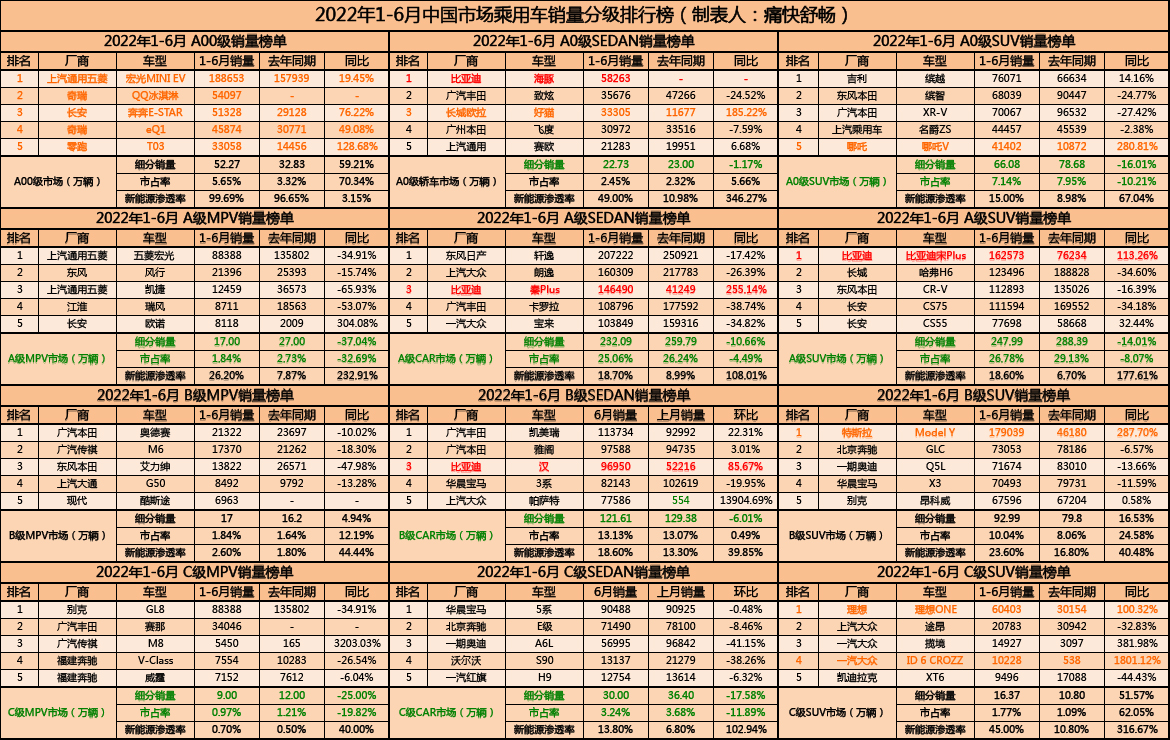
We can see that in the 12 sub-segments, BYD mainly targets the A0-level sedans, A/B-level sedans, and SUVs, with a market share of 77.47%. It does not cover the 7 sub-segments of A00-level sedans, A0-level SUVs, C-level sedans and SUVs, MPVs, etc., which have a market share of 22.44%.
Currently, BYD mainly focuses its efforts on the A0-level sedans, A/B-level sedans, and SUVs priced between 100,000 to 200,000 yuan, rather than expanding its market to a larger extent. The Song max DM-i launched in the first half of this year is essentially a continuation of its previous products.
All 5 of the sub-segments targeted by BYD have hit products.
1) The A0-level sedan has a market share of 2.45% and a market size of around 600,000 cars.
BYD’s Dolphin has become the sales champion with a market share of 25.63%. It is expected that by the end of the year, the Dolphin will achieve a share of nearly 40% in this sub-segment, becoming the absolute champion.
2) The A-level sedan has a market share of 25.06% and a market size of around 5.5 million cars.
BYD’s Qin Plus ranks third in the sales chart with a market share of 6.5%. It is expected that by the end of the year, Qin Plus will achieve a share of 10% in this sub-segment, becoming the No.2 in this sub-segment.3)The market share of A-level SUV is 26.78%, with a market size of approximately 6 million vehicles.
BYD Song Plus has become the sales champion with a market share of 4.5%. It is expected that by the end of the year, Song Plus will take 6% of this segment market share and become the new sales champion in this market.
4)The market share of B-level sedan is 13.13%, with a market size of approximately 2.8 million vehicles.
BYD Han ranked third in the sales list with a market share of 7.98%. It is expected that by the end of the year, Han will take 10% of this segment market share and become the number one in this segment market.
5)The market share of B-level SUV is 10.04%, with a market size of approximately 2.2 million vehicles.
BYD Tang ranked eighth in the sales list with a market share of 4.55%. It is expected that by the end of the year, Tang will take 6% of this segment market share and become one of the top five in this segment market.
By September 2022, BYD has formed its own best-seller matrix (based on September sales data)!
-
The Song Plus family: monthly sales of more than 45,000 units;
-
The Qin Plus family: monthly sales of more than 40,000 units;
-
The Han family: more than 30,000 units;
-
The Dolphin series: more than 25,000 units;
-
The Yuan family: more than 23,000 units;
-
The Tang family: more than 15,000 units;
-
Newly launched Sea Lion is expected to exceed 15,000 units; the Destroyer 05 is expected to exceed 10,000 units.
The cumulative sales of 8 series models now reach a level of more than 200,000 units and each of them can enter TOP5 in each segment market.
2. BYD’s Best-seller Matrix in 2023
If we base ourselves on the 2022 best-seller matrix and refer to the upcoming models to be released in 2023, we can have a clearer prediction of BYD’s monthly sales level in 2023.
1) Dynasty Network: Monthly sales target of more than 160,000 and annual sales target of more than 2 million.
-
The Han family: EV’s sales target is more than 15,000 and DM-i’s sales target is more than 15,000, totaling more than 30,000 units per month, with annual sales of more than 350,000, becoming the unquestionable sales champion for B+C level sedan.
-
The Tang family: DM-i’s sales target is more than 10,000 and EV’s sales target is more than 10,000, totaling more than 20,000 units per month, with annual sales of more than 240,000, becoming the sales champion for B-level SUV.
-
The Song family: DM-i’s sales target is more than 40,000 and EV’s sales target is more than 10,000, totaling more than 50,000 units per month, with annual sales of more than 600,000, becoming the sales champion in the SUV market.- Qin Family: The sales target for DM-i is 30,000+ and for EV is 10,000+, with a total of 40,000 units per month and an annual sales target of 500,000+. It aims to become the top-selling sedan in the market.
-
New models: Three products including sedan, SUV, and MPV, with an annual sales target of 200,000+ units.
-
Haiyang: The monthly sales target is 95,000+ and the annual target is 1.2 million+.
-
Biology series: The sales target for Dolphin is 30,000+ units and for Sea Lion is 20,000+ units, with a total of 50,000 units per month and an annual sales target of 600,000+. It aims to become one of the top 5 pure electric car models worldwide.
-
Warship series: The sales target for Destroyer 05 is 10,000+ units and for Frigate 07 is 10,000+ units, with a total of 20,000 units per month and an annual sales target of 240,000+. It forms an effective complement to Wangchao.com.
-
New models: The sales target for Seagull is 5,000+ units, for Seal is 10,000+ units, for Frigate 05 is 10,000+ units, and for HX is 5,000+ units, with a total of 30,000 units per month and an annual sales target of 300,000+.
-
DENZA: The monthly sales target is 55,000+ and the annual target is 300,000+.
-
MPV series: The sales target for D9 DM-i is 10,000+ units and for EV version is 3,000+ units, with a total of 13,000+ units per year and aiming to become the leader in the MPV market.
-
INCEPTION: The sales target is 10,000+ per year.
-
SUV series: The sales target for the current X model is 10,000+ units, and for the mid-to-large SUV is 10,000+ units, with a total of 20,000+ units and an annual sales target of 60,000+ (expected to be officially delivered in Q3 2023).
-
Sedan series: The mid-to-large sedan is expected to be officially released in H2 2023.
-
Premium brand: Four models with an annual sales target of 10,000+ units.
-
Mysterious brand: Yes, BYD has a fifth channel or brand targeting a more trendy and fashionable customer base, with an expected annual sales target of 50,000+ units in 2023.
Overall, the sales target is around 3.5-3.6 million units, including Wangchao.com -2 million+, Haiyang.com -1.2 million+, DENZA -300,000+, premium brand -10,000+, and mysterious brand -50,000+.
Looking at BYD’s Overseas Sales Layout for Next Year
On September 28th, BYD held a European passenger car launch, announcing its entry into the European market. By 2022, BYD has already expanded to 40 countries and regions worldwide, including 22 in Asia, 10 in Europe, 3 in Oceania, and 6 in South America.
In New Zealand, the BYD Yuan Plus EV ranked third in the country’s EV sales leaderboard with 448 units sold in the second month since its launch.
In Australia, 1500 units of the Yuan Plus have arrived and another 800 units are on the way. This indicates the potential for the Yuan Plus to become a global best-seller.
In Brazil, the first batch of 200 units of the Song Plus DM-i has been fully booked, and the delivery is expected to be completed in December this year. The second batch of 250 units was open for pre-order on September 28.
In Hong Kong, prior to the 11th Golden Week, BYD held its first car show, with orders expected to exceed 3,000 units for Dolphin and Delphin EVs.
In Thailand, BYD will build its first overseas passenger vehicle assembly plant, which is expected to be completed and put into production in 2024 with a planned production capacity of 150,000 units. The plant will mainly serve the ASEAN and European markets.
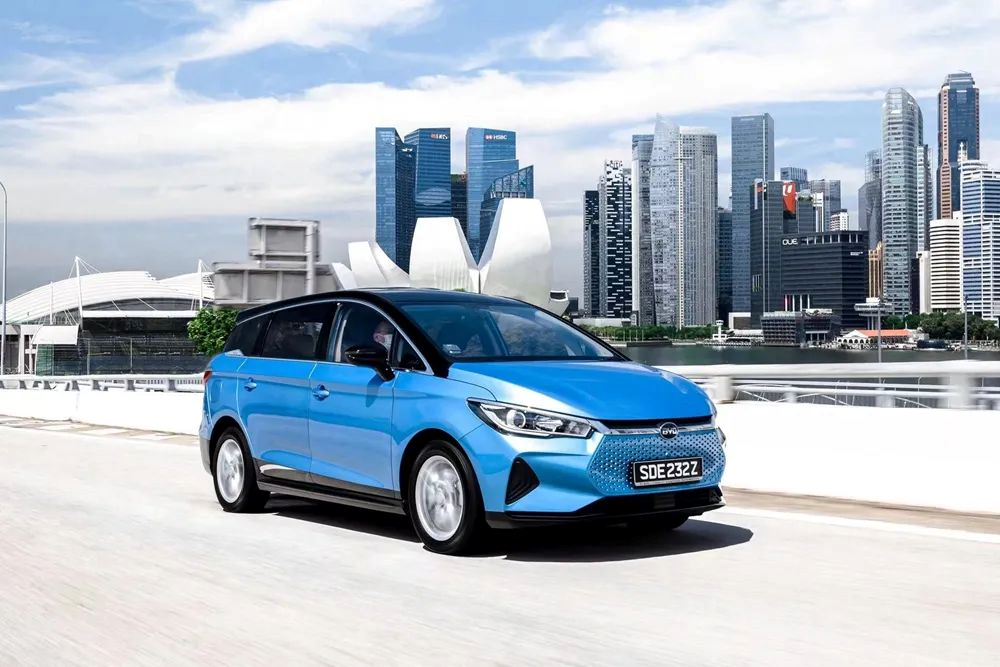
BYD is planning to build its first overseas factory in Thailand with a planned capacity of 150,000 units, and will launch models including Yuan Plus EV, Han EV, Tang EV, Qin Plus DM-i, Song Plus DM-i, and Dolphin in the Thai market. Additionally, BYD will participate in the 39th Bangkok International Auto Show from December 1st to 12th, 2022.
As BYD expands its presence in global markets, at least 4 global models will serve as the main export models in the future.
1) Yuan Plus EV: As the sales champion of the compact pure electric new energy SUV in the domestic market, this model is highly competitive in terms of size and price in the global market. It is expected that the monthly sales volume including overseas markets will exceed 50,000+ next year.
2) Song Plus DM-i: As the sales champion of the compact SUV in the domestic market, Song Plus has developed multiple overseas versions (left-hand drive EU standards, right-hand drive EU standards, and international standards). It is reported that the Song Plus will serve as the main product for overseas markets next year (especially in Europe and South America), and it is expected that the monthly sales volume including overseas markets will exceed 80,000+ next year.3) Seal: As the culmination of the e platform 3.0, it will mainly be pushed to the European market, with sales benchmarking against competing models. It is expected that monthly sales, including overseas markets, will exceed 30,000+ next year;
4) Dolphin: As an entry-level product of the e platform 3.0, it has already fully demonstrated its competitiveness in the domestic market. If it enters the Southeast Asian market, it will also be a popular product. It is expected that monthly sales, including overseas markets, will exceed 50,000+ next year.
Of these four global models, at least 2-3 models are expected to enter the TOP5 of the global new energy vehicle sales chart in 2023.
In September, BYD announced that its recent export volume was 7,736 units, and BYD has already accumulated exports of 22,749 units from January to September.
It is reported that BYD’s initial reservation volume for overseas markets has exceeded 100,000, with a monthly sales target of 30,000 and an expected annual sales target of 300,000 units.
Conclusion
- Looking back at the 20-year development history of China’s domestic passenger car brands, countless times have proven that “there is no era without companies, only companies in the era.”
This time, BYD, which has stepped on the rhythm of the times, has the opportunity to surpass the annual sales record and market share record of the single brand created by joint venture brands in the Chinese market!
- Combined with BYD’s explosive product matrix in 2022, it is highly likely to achieve 3.6-4 million units.
The domestic sales target is around 3.5 million units (of which Wangchao 2 million+, Ocean 1.2 million+, Tang 300,000+, high-end 10,000+, new brand 50,000);
The overseas sales target is around 300,000 units (Wangchao website 150,000 units, Ocean website 140,000 units, others 10,000 units).
Breaking it down, BYD’s sales target for 2023 is approximately 3.8 million units.
3. Regardless of whether BYD can achieve the feat of selling 4 million units annually in 2023, it will undoubtedly create a miracle in the sales of domestic and new energy brands!
–END–
This article is a translation by ChatGPT of a Chinese report from 42HOW. If you have any questions about it, please email bd@42how.com.
